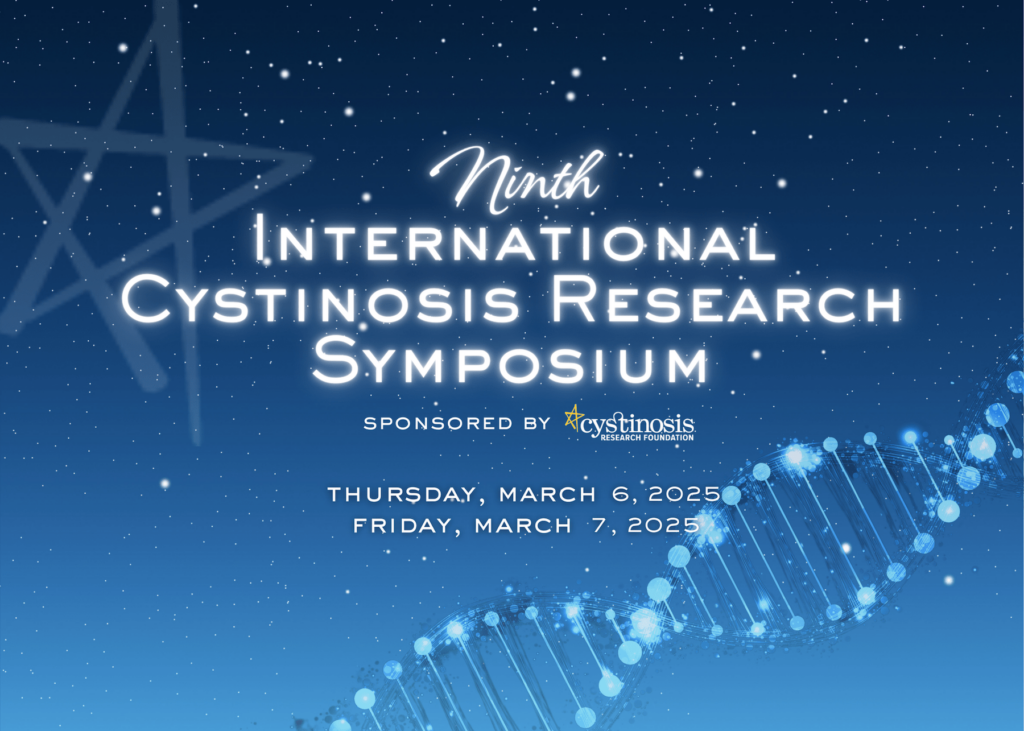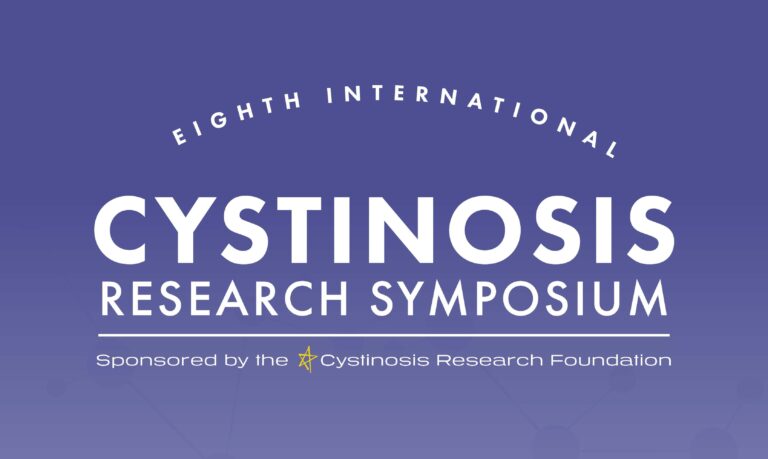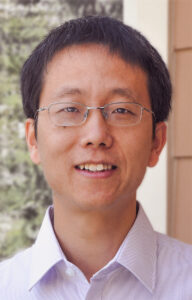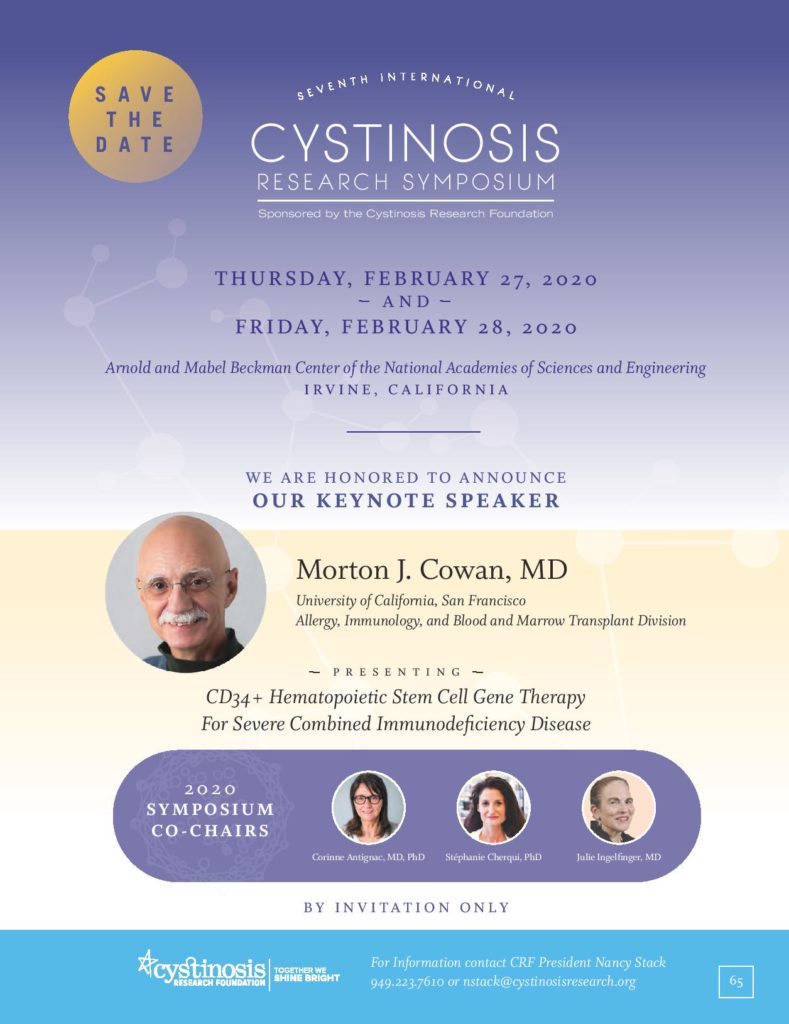

Cystinosis Research Symposium Summary
By Stephen Jenkins, MD, and CRF Scientific Review Board Member
On Thursday, March 6, and Friday, March 7, 2025, over 40 researchers from seven countries gathered in Newport Beach, California, for the Ninth CRF International Cystinosis Research Symposium. It was exciting to see new researchers joining the field and to witness the progress being made in translating research from the lab to patient care.
Dr. Melissa Wigderson from Novartis Pharmaceuticals gave the keynote address on the development of Onasemnogene Abeparvovec-xioi, a gene therapy for Spinal Muscular Atrophy. This gene therapy uses an adeno-associated virus (AAV) to deliver functional copies of the mutant gene to motor neurons. This gene therapy was approved by the FDA in 2019, and since that time over 4,000 patients have been treated. Importantly, Novartis Pharmaceuticals purchased the cystinosis gene therapy program, and Dr. Widgerson will oversee the clinical trials of gene therapy for cystinosis.
Dr. Stéphanie Cherqui presented her research on the Phase 1/2 clinical trial of autologous hematopoietic stem cell gene therapy for cystinosis. Six participants, ages 20-46 years, were transplanted, and Dr. Cherqui now has follow-up data up to 63 months on the first patient. White blood cell cystine and tissue cystine crystals in skin and rectal mucosa have decreased compared to baseline. Patients 1 and 3 have experience improvement in muscle strength and motor coordination. Patients 4 and 5 have low vector copy numbers and have restarted a low dose of cysteamine therapy. She is applying the same gene therapy design to other rare genetic diseases, like Friedreich’s ataxia and Danon disease, as well as much more common diseases like Alzheimer’s.
Beyond gene therapy, other regenerative medicine approaches are in development. Dr. Paul Goodyer discussed mRNA therapy, pioneered by Moderna for vaccines, as a potential way to restore cystinosin production. Transfecting patient-derived cells with normal cystinosin mRNA resulted in increased protein production, reduced cystine levels, and improved autophagy. Moderna is already advancing mRNA therapies for other rare diseases in Phase 2 trials.
Dr. Beno Freedman’s research on induced pluripotent stem cells (iPSCs) and kidney organoids showed promising results. By using CRISPR to correct the CTNS gene in iPSCs derived from cystinosis patients, he created kidney organoids that integrated into mouse kidneys, potentially paving the way for future organ regeneration.
Repurposing FDA-approved drugs for cystinosis treatment is a promising strategy. Dr. Alessandro Luciani and Dr. Olivier Devuyst used artificial intelligence to identify drug candidates. MTORC1 inhibitors like sirolimus showed potential but had significant side effects. SGLT-2 inhibitors such as dapagliflozin, already approved for adults with chronic kidney disease and proteinuria, improved lysosomal function and proximal tubule health in preclinical models.
Dr. Francesco Emma and Dr. Esther De Leo tested genistein, a supplement that lowered cystine levels in cystinosis knockout mice but failed in rats, suggesting limited human applicability. Dr. Sergio Catz screened drug libraries and identified candidates that enhance autophagy, including an FDA-approved drug for kidney disease. His lab is also studying the role of chronic inflammation in cystinosis and potential anti-inflammatory therapies.
Dr. Bruce Barshop is investigating different prodrug versions of cysteamine. Prodrugs are designed to be activated within the target cell or organ so that there are fewer systemic side effects. One of the prodrugs he studied successfully lowered cystine levels in fibroblasts, but it had toxic side effects and killed the cells. Dr. Herbie Newell and Dr. Jennifer Hollywood are investigating another cysteamine prodrug called CF10 that is safe and effective in animal models.
Dr. Liang Feng studied cystinosin protein conformations and proposed using small molecules to enhance its open state for better cystine transport. Dr. Ming Li identified a rare cystinosis mutation causing rapid protein degradation and successfully stabilized it with a chaperone drug, potentially enabling precision medicine for similar mutations.
We talk a lot about new medications for cystinosis, but what about dietary approaches? Dr. Francesco Bellomo shared an update on the use of ketogenic diet in cystinosis, which they have studied in both knockout mice and rates. If started early, the ketogenic diet could prevent the development of Fanconi syndrome. The diet also increased production of proteins involved in muscle regeneration, suggesting there may be a role for muscle disease as well. The diet has yet to be studied in humans with cystinosis, but Dr. Francesco Emma plans to do a trial soon.
Dr. Lauren Albrecht is studying the way different lysosomal metabolites may affect the pathogenesis of kidney and bone disease in cystinosis, and whether restoring normal levels of these metabolites outside the lysosome may improve cell function. Dr. Olivia Pagliarosi and Dr. Andrea Del Fattore examined Pepstatin A, a cathepsin D inhibitor, which increased bone mass and density in cystinosis knockout mice. They also found that cysteamine is toxic to osteoblasts, potentially explaining bone fragility in patients.
Dr. Maren Leifheit-Nestler shared an update on her lab’s research on musclin, a muscle-derived myokine that impedes muscle atrophy and is highly expressed during exercise. They measured musclin levels in 35 patient with cystinosis, and they are significantly reduced compared to healthy controls. Musclin could be used as a biomarker to assess treatments for myopathy, or it may be a target for treatment itself.
Dr. Aude Servais and her team used whole-body MRI to assess 47 muscles in cystinosis patients, identifying tongue, trapezius, deltoids, forearm extensors, soleus, and gastrocnemius muscles as the most affected. MRI findings correlated with swallowing and respiratory issues, providing a valuable tool for assessing future treatments.
Dr. Reza Seyedsadjadi is conducting a clinical trial to improve swallowing function in cystinosis. He is recruiting 30 adults for randomized interventions, including respiratory therapy, tongue muscle exercises, and behavioral feedback training, aiming to identify tailored therapies for dysphagia.
The symposium showcased the remarkable scope of cystinosis research. From gene therapy to dietary interventions and drug repurposing, scientists are pursuing multiple avenues to improve patient outcomes. Despite political challenges to research funding, the Cystinosis Research Foundation continues to support these efforts, thanks to dedicated fundraisers and generous donors. The progress being made gives families like mine hope for a brighter future.


The Eighth International CRF Cystinosis Research Symposium was held on September 7, and September 8, 2023, with CRF-funded researchers and scientists from seven countries around the world in attendance at the prestigious symposium. The conference was organized by CRF symposium co-chairs, Corinne Antignac, MD, PhD, Julie Ingelfinger, MD, and Stéphanie Cherqui, PhD. We thank the co-chairs for their leadership and commitment to CRF and the cystinosis research community. The two-day symposium allowed CRF researchers to present their research studies and progress to explore new ideas and form collaborations to advance and accelerate new research ideas.
We were honored to have Liang Feng, PhD, from Stanford University, give the keynote address, “The Structure, Mechanism, and Dynamics of Cystinosin” based on his recent, highly acclaimed work published in Cell. Dr. Feng’s published article is available to download here.
We extend a very special thank you to the nine CRF Scientific Review Board (SRB) members for their leadership and guidance. Their dedication to CRF and their vision for a global research community has created an extraordinary, synergistic, collaborative research community. With gratitude, we thank the SRB members; Corinne Antignac, MD, PhD, Sergio Catz, PhD, Stéphanie Cherqui, PhD, Francesco Emma, MD, Laurence Greenbaum, MD, PhD, Paul Grimm, MD, Julie Ingelfinger, MD, Stephen Jenkins, MD, and Aude Servais, MD, PhD. We are grateful to the CRF-funded researchers for their dedication to finding better treatments and a cure for cystinosis.
2023 Symposium Keynote Speaker
LIANG FENG, PhD

Associate Professor
Molecular and Cellular Physiology
Stanford University
Seventh CRF International Research Symposium
By Stephen Jenkins, MD, CRF Board Member
 The seventh biennial CRF International Research Symposium in Irvine, California was a huge success. Scientists from all over the world came together to share their CRF-funded research on cystinosis. Many researchers attended for their first time, and they were warmly welcomed into our community.
The seventh biennial CRF International Research Symposium in Irvine, California was a huge success. Scientists from all over the world came together to share their CRF-funded research on cystinosis. Many researchers attended for their first time, and they were warmly welcomed into our community.
As a parent of two children with cystinosis, I was most excited to hear about new potential therapies. This was my third time attending the symposium, so it was exciting to see the progress that scientists have made. Earlier projects that focused on mechanisms and cellular biology have yielded potential therapeutic targets, and now the scientists are testing these therapies in animals.
The keynote speaker of the conference was Dr. Morton J. Cowan, from UC San Francisco, who is a distinguished researcher and physician who has pioneered gene therapy for different types of severe combined immunodeficiency (SCID).
Dr. Cowan’s presentation was followed by Dr. Stéphanie Cherqui, who gave an update on the first gene-corrected autologous stem cell transplant in a human with cystinosis. So far, the trial participant, who we now all know is Jordan Janz, has done well. He has a good level of corrected cells (vector copy number of 2 as measured in the blood cells) and his white blood cell cystine levels have dropped from 7.8 nmol at the time of transplant to 1.5 nmol three months after transplant. This is an important proof of concept that the blood cells have been repaired, but what about the tissue? Preliminary results based on confocal microscopy of the skin show reduced cystine crystals. His urine output has decreased as well, and he has been able to reduce his phosphorus supplementation, suggesting a possible improvement in Fanconi syndrome. He will return to California in April for his six-month check-up, where they will do biopsies to look at cystine in the tissue. It was a very exciting talk!
Dr. Morgan Fedorchak gave us an update about controlled-release cysteamine eye drops, which she has been testing in rabbits (without cystinosis) and will now be testing in cystinosis knockout mice.
Dr. Laura Rega shared research she has done with Dr. Francesco Emma on compounds that stimulate TFEB and improve regulation of lysosome turnover and autophagy. When given to cystinosis knockout mice, there was a significant reduction in kidney cystine, even without cysteamine therapy. There also appeared to be improvement in Fanconi syndrome. Next, they plan to test these compounds in cystinosis knockout rats, and hopefully humans in the future.
Dr. Pierre Courtoy has previously found that knocking out a certain protein called “megalin” in the kidney prevents cystine accumulation and protects the proximal tubules. He hypothesized that inhibiting megalin with large doses of amino acids would have a similar effect. Early results were promising, however, the long-term studies are less conclusive.
Dr. Paul Goodyer gave an update on a new medication that may treat patients with CTNS nonsense mutations. They’ve tested it on three patients for three weeks, and there was no evidence of toxicity. The study identified a dosing threshold where WBC cystine levels begin to fall. Additional studies from the lab show that the drug can repair the defect in cellular autophagy as well. From lessons learned in the first phase, the protocol will be adjusted and then expanded at additional sites in the USA.
Dr. Robert Mak is collaborating with Dr. Hal Hoffman, a prior symposium keynote speaker, on studying the effects of inflammation in cystinosis. They believe that by blocking the inflammasome pathway they can improve Fanconi syndrome.
They have been testing two compounds in this pathway in knockout mice, and they have had improvement in urine output and markers of Fanconi syndrome. New oral medication that blocks this pathway is currently being tested in a phase III trial, so they plan to obtain this compound for additional studies.
Dr. Francesco Bellomo shared research he has done with Dr. Emma on whether the ketogenic diet may be beneficial in cystinosis. They have tested it in knockout mice and found that it reduced polyuria, glycosuria and tubular proteinuria, a sign that it may help Fanconi syndrome. It also reduced inflammation and fibrosis in the kidneys. It is unclear why a ketogenic diet had this effect, so they are going to continue research on this question. The ketogenic diet may lead to ketoacidosis, and people with cystinosis already have metabolic acidosis, so any dietary treatment should require close monitoring and testing in humans.
Dr. Sergio Catz has been studying the effects of cystinosis on chaperone-mediated autophagy for several years, and he tested a molecule in this pathway that may rescue this important function in cells. He created jellybeans containing the compound and fed them to knockout mice, and they had decreased polyuria, phosphaturia and proteinuria, which may mean improvement in Fanconi syndrome. There was no change in cystine levels, so it would likely need to be taken along with cysteamine.
In addition to these exciting updates on possible therapies for cystinosis, we heard talks about bone, muscle, and neurologic disease, which are very important issues as people with cystinosis live longer. We heard many talks about the molecular mechanisms of cystinosis, which may yield therapeutic targets in the future. Multiple scientists also shared new models for studying the disease, including genetically engineered rats, zebrafish and stem-cell derived organoids. Dr. Benjamin Freedman was invited to give the keynote address on his work creating polycystic kidney organoids two years ago, and now he is currently working on creating cystinosis organoids which could be used to study the disease and test new drugs.
It was exciting to see the scientists ask each other tough questions and help each other troubleshoot their experiments in a collaborative way.
Every symposium breeds new connections, and I’m excited to see what comes out of these partnerships. I am grateful for all their hard work and I’m amazed at how much the CRF and these scientists have been able to accomplish. It gives me and my family so much hope for the future.
